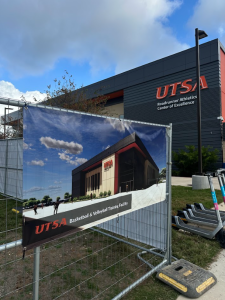Did we really make the right call?
Why schools should return to in-person classes despite the coronavirus threat.
November 6, 2020
When schools prepared for the transition back into fall classes for 2020, they were forced to make the tough decision of whether or not they should resume in-person instruction and create a greater risk for students to become infected with COVID-19 or to play it safe and conduct instruction online. UTSA decided to play it safe and push all classes online while keeping campus open. While some may appreciate the decision because it protects the health of the students, many students are frustrated about spending another semester online because of the struggles in keeping a consistent schedule, keeping up with due dates and deadlines, and the lack of socialization.
The University of Notre Dame was one of the many universities that decided they would return to campus this fall amidst concerns of the coronavirus. Before classes resumed, they tested all 11,836 of their students. Of the total, 33 students, or 0.28%, tested positive and could not be on campus until they were cleared by a medical professional, according to an article published by Notre Dame Campus News. The school took every precautionary measure possible to ensure an outbreak would not occur, including distributing masks, ensuring facility cleanliness and giving students hand sanitizer.
But, nearly eight days after classes had resumed, the campus had 147 confirmed cases, 16% of those testing positive. This left the university forced to switch to online instruction, according to an article released by ABC News. This outbreak was reportedly not a result of spreading the virus on campus. The initial outbreaks were tied to a couple of off-campus parties where students weren’t wearing masks, and the virus spread quickly from there. Although this shows how dangerous and easy it is for the coronavirus to spread, it was the result of extremely poor choices on the part of the students who didn’t take the precautionary measures necessary to prevent these outbreaks, and all students at the school shouldn’t have had to pay the price.
This example may prove to some that it would be too dangerous to resume in-school instruction at this time, but the need for in-person instruction greatly outweighs the risk for many.
According to a poll conducted on May 13 by College Reaction, 65% of students would return to campus in person even if a vaccine had not been developed by then. As we now know, there is still no vaccine, but this still shows how much students dislike online instruction and that they would prefer to get instruction in-person even with the greater risks involved.
Stanford conducted their own survey with 6,000 of its students this fall and found that over 80% of students indicated difficulty with focusing during online instruction. They also found that nearly half of all undergraduates, specifically first-generation or low-income students, indicated they did not have access to a quiet, productive and private place to study. Of all students, 16% had significant trouble with internet access half the time or more.
This transition has not only created difficult barriers for people who rely on attending campus in-person, it has also made for an extremely difficult transition for students in general.
Despite the numerous concerns with students returning to campus as well as the multiple outbreaks that have already occurred on campuses across the U.S., campuses should still return to in-person instruction with a strong emphasis on protecting the safety of the students by providing testing and containment education to ensure that outbreaks do not occur. Students are struggling with the current method of online education, and in the end, we should be focusing on providing them with the best educational experience possible.
These students are America’s future.






